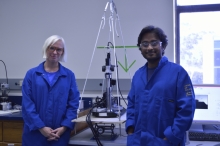
University:
Major:
Mentor(s):
Faculty Sponsor(s):
Faculty Sponsor's Department:
Project Title:
Project Description:
In the electronics industry it is crucial to scale devices in order to retain the functional performance of transistors. In other words, as transistors become smaller, it is crucial to precisely control the position and the concentration of dopant atoms in the semiconductor channel to maintain their function. It has been recently shown that such a control can be achieved using kinetic block copolymer self-assembly, wherein the position of the incorporated dopant atoms is a function of the morphology expressed by the block copolymer. Lateral ordering of such kinetically trapped block copolymer micelles can be further enhanced by directed self-assembly (DSA). Here we seek to understand: 1) the kinetic self-assembly process of block copolymers in solution and 2) the DSA of polymer micelles in nanoscopic non-planar architectures. Our experiments suggest that the size, spacing and the polydispersity of the block copolymer (PS-b-P4VP) micelles depend on the composition of the solvent that the polymer chains are dissolved in. Specifically, strongly selective solvents such as toluene (for PS) result in the formation of micelles of various sizes and shapes. On the other hand, incorporating a small amount of a good solvent such as THF, results in the formation of more monodisperse spherical micelles. Thin films of these micelles deposited on pre-patterned silicon substrates were characterized via atomic force microscopy. Our results indicate that the various nanoscopic features (trenches and fins) on the wafers constituted an important parameter for DSA of the micelles. The lateral order was further improved via solvent vapor annealing.
